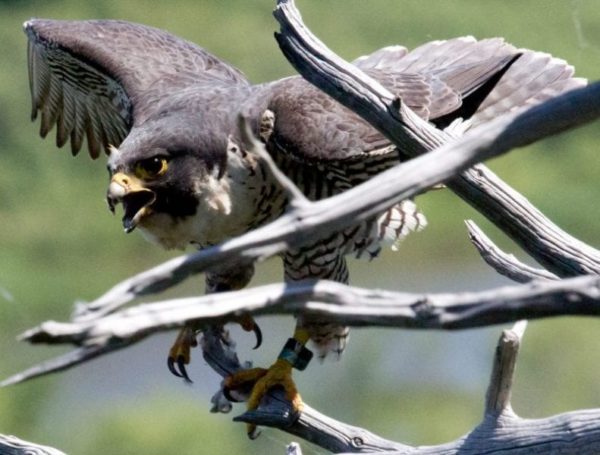Information About The Bird
Peregrine Falcon (Falco peregrinus)
Seen/Heard at
Great Spirit Bluff, Decorah North, Mississippi Flyway
Diet
Peregrine Falcons feed primarily on other birds they catch in the air. We’ve found the remains of Pie-billed Grebes, Pigeons, American Robins, Blue Jays, Grackles, Cedar Waxwings, Gulls, Yellow-shafted Flickers, Bluejays, Wilson’s Snipe, Mallards, Gulls, Killdeer, Downy Woodpeckers, Hairy Woodpeckers, Terns, Soras, Rails, and Baltimore Orioles. In general, the prey remains we find reflect local birds, although peregrines seem to have a preference for large birds, most likely because they provide a larger meal for the amount of effort expended.
Peregrine Falcons have also been documented eating small mammals and carrion. Scavenging is more common in younger birds than older birds, and may be more common in some biomes than others. Kleptoparasitism may also be more common than we know. It has been documented in Spain (Carrion Crows), Russia (Imperial Eagles, Osprey), and the United States (Osprey, unknown bird of prey). In most cases, a Peregrine Falcon attacked another bird that was carrying prey. When the attacked bird dropped it, the Peregrine Falcon recovered it from the air and flew away to eat it elsewhere or bring the stolen prey back to the nest for young. Bob found a fish in a peregrine nest in Minneapolis and we witnessed a female falcon at Great River Energy bring in a 13-lined ground squirrel in 2008. Falcon Michelle brought in little brown bats at Great Spirit Bluff in 2016 and 2017, although they aren’t a common prey item. This video shows her eating a bat before civil sunrise, which indicates she was out hunting before daybreak: https://youtu.be/hblwIr0nuAY.
Nesting
Peregrine Falcons breed from mid-March through early June (although reproductive activities may start in early February). They usually nest on ledges and in potholes, crevices, and nest boxes, although they sometimes choose open gravel-topped roofs and gutters. Males establish territories and court females with display flights and gifts of food. Peregrine nests are often started by males, who use their feet and bodies to scrape shallow depressions in whatever substrate is available, including dirt, sand, pebbles, sawdust, nesting debris, gutter run-off, and gravel. Females assist in later stages of construction by tailoring the scrape to their liking. Peregrine falcons lay two to four eggs per clutch and produce one brood per year. Both parents incubate eggs for 32-36 days and young stay in the nest for 38-41 days. To learn more, visit Cornell’s website.
Although it isn’t common, tree nesting has been documented in peregrine falcons in the United States as recently as 2013. The authors of the short communication Tree-Nesting by Peregrine Falcons in North America: Historical and Additional Records reviewed literature and found 33 North American records of peregrine falcons nesting in trees or snags in Alaska, Kansas, Illinois, Tennessee, Louisiana, Virginia, and British Columbia. You can read more about that here: https://raptorresource.blogspot.com/2017/05/a-peregrine-falcon-at-decorah-north-nest.html.
Citations
Bird Range Maps of North America
Ridgely, R.S., T.F. Allnutt, T. Brooks, D.K. McNicol, D.W. Mehlman, B.E. Young, and J.R. Zook. 2003.
Digital Distribution Maps of the Birds of the Western Hemisphere, version 1.0. NatureServe, Arlington, Virginia, USA. Data provided by NatureServe in collaboration with Robert Ridgely, James Zook, The Nature Conservancy – Migratory Bird Program, Conservation International – CABS, World Wildlife Fund – US, and Environment Canada – WILDSPACE.
Web Link: http://bit.ly/2ynPQ5I
The Cornell Lab of Ornithology Birds of North America: https://birdsna.org/Species-Account/bna/species/perfal/introduction.
Kleptoparasitism – one of hunting technique of the Peregrine Falcon that became common under condition of the increase in its number in the Southern Ural Mountains, Russia: http://rrrcn.ru/en/archives/19448.
A Peregrine falcon at the Decorah North Nest! https://raptorresource.blogspot.com/2017/05/a-peregrine-falcon-at-decorah-north-nest.html.
General Description
Adult Peregrine Falcons have slate blue upper parts with white barred underparts. They have dark heads, pale cheeks, and a mallar stripe (or mustache) that extends downwards from their eye. Their breasts may be all-white or contain a buff, salmon, or peach color. Juveniles are brown and heavily marked, with vertical streaks instead of horizontal bars on the breast.
Migration
Migratory sighting in Decorah, resident and migratory sightings at Great Spirit Bluff. Peregrine Falcons are partial migrators: some migrate and some do not. Our birds have been reported on oil rigs in the Gulf of Mexico, on beaches in Cancun, and in the forests of Costa Rica. They do not live in the Decorah area as far as we know.
Measurements
Length: 14.2-19.3 in/36-49 cm
Wingspan: 39.4-43.3 in/100-110 cm
Weight: 18.7-56.4 oz/530-1600 g
Wing Design
High Speed Wings. Peregrine falcons are the world’s fastest flyers, and their long, pointed wings reflect their high-speed flight.
| See also different: | Decorah North Nest, Falcons, Great Spirit Bluff, Mississippi River Flyway |
